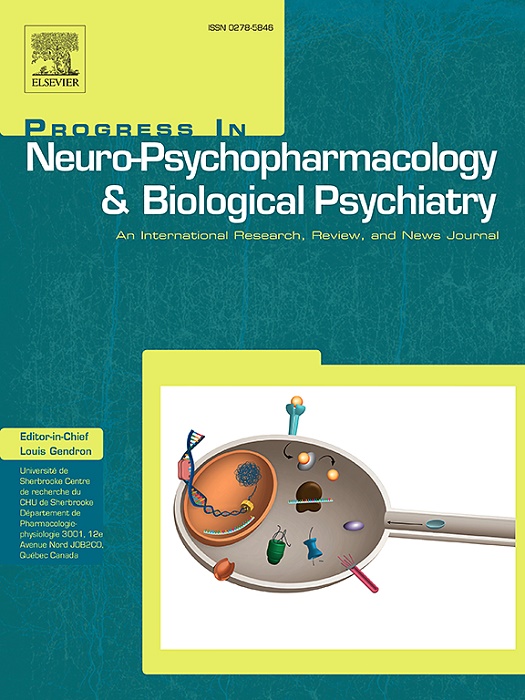A salutogenic signature of the placebo effect in brain oscillations: A systematic review and meta-analysis
IF 3.9
2区 医学
Q1 CLINICAL NEUROLOGY
Progress in Neuro-Psychopharmacology & Biological Psychiatry
Pub Date : 2025-10-02
DOI:10.1016/j.pnpbp.2025.111518
引用次数: 0
Abstract
Background
The placebo effect is increasingly recognized in rehabilitation, yet its mechanisms remain poorly understood. Brain oscillations offer a non-invasive, time-sensitive and dynamic measure of neural activity, making them ideal for capturing the dynamic changes linked to placebo responses. This study explores oscillatory activity as a biomarker of the placebo effect's neural basis.
Methodology
A systematic literature review up to September 2024 searched PubMed, Embase, and Cochrane databases for randomized controlled and cross-over trials reporting brain oscillations in resting state from placebo-controlled neurorehabilitation trials in healthy and subjects with neurological disorders. The analysis included a semi-quantitative (albatross plots), and quantitative meta-analysis (Hedge's g), focusing on the effect sizes of power differences between placebo and active groups.
Results
We included 63 studies with 180 healthy subjects and 1758 neurological disorder patients. In healthy subjects, placebo showed an increase in alpha power compared to no intervention (g = 0.45, 95 % CI [0.09; 0.8]). In patients, sham interventions elevated alpha power in frontal (g = 0.08, 95 % CI [0.07; 0.08]), central (g = 0.55, 95 % CI [0.47; 0.65]), and parietal areas (g = 0.28, 95 % CI [0.18; 0.44]), as well as beta (g = 1.31, 95 % CI [1.06; 1.63]) and theta central (g = 0.58, 95 % CI [0.46; 0.72]). These effects were non-significant when compared to active interventions.
Conclusion
Alpha oscillations in fronto-central regions are the primary biomarkers of the placebo effect, with beta and theta oscillations also indicative, especially in patients with neurological disorders. These effects were reversed when compared to active interventions, suggesting that active rehabilitation also encompass the placebo effect. Intriguingly, these placebo effects vary based on baseline brain activity, highlighting a tendency towards more stable, salutogenic rhythms in different populations.
脑振荡中安慰剂效应的健康标志:系统回顾和荟萃分析。
背景:安慰剂效应在康复治疗中得到越来越多的认可,但其机制尚不清楚。大脑振荡提供了一种非侵入性的、时间敏感的、动态的神经活动测量方法,使其成为捕捉与安慰剂反应相关的动态变化的理想方法。本研究探讨振荡活动作为安慰剂效应的神经基础的生物标志物。方法:系统文献综述,检索PubMed, Embase和Cochrane数据库,检索随机对照和交叉试验,报告健康和神经系统疾病受试者的安慰剂对照神经康复试验中静息状态下的脑振荡。分析包括半定量分析(信天翁图)和定量荟萃分析(赫奇g),重点关注安慰剂组和积极组之间权力差异的效应大小。结果:我们纳入了63项研究,涉及180名健康受试者和1758名神经系统疾病患者。在健康受试者中,与未干预相比,安慰剂显示α功率增加(g = 0.45,95% % CI[0.09; 0.8])。在病人,虚假的权力干预高α额(g = 0.08,95 % CI[0.07, 0.08]),中央(g = 0.55,95 % CI[0.47, 0.65]),和顶叶区域(g = 0.28,95 % CI[0.18, 0.44]),以及β(g = 1.31,95 % CI[1.06, 1.63])和θ中央(g = 0.58,95 % CI[0.46, 0.72])。与积极干预相比,这些影响不显著。结论:额-中枢区域的α振荡是安慰剂效应的主要生物标志物,β和θ振荡也是指示性的,特别是在神经系统疾病患者中。与积极干预相比,这些效果被逆转,这表明积极康复也包含安慰剂效应。有趣的是,这些安慰剂效应根据大脑活动的基线而变化,在不同的人群中突出了更稳定、更有益健康的节奏的趋势。
本文章由计算机程序翻译,如有差异,请以英文原文为准。
求助全文
约1分钟内获得全文
求助全文
来源期刊
CiteScore
12.00
自引率
1.80%
发文量
153
审稿时长
56 days
期刊介绍:
Progress in Neuro-Psychopharmacology & Biological Psychiatry is an international and multidisciplinary journal which aims to ensure the rapid publication of authoritative reviews and research papers dealing with experimental and clinical aspects of neuro-psychopharmacology and biological psychiatry. Issues of the journal are regularly devoted wholly in or in part to a topical subject.
Progress in Neuro-Psychopharmacology & Biological Psychiatry does not publish work on the actions of biological extracts unless the pharmacological active molecular substrate and/or specific receptor binding properties of the extract compounds are elucidated.

 求助内容:
求助内容: 应助结果提醒方式:
应助结果提醒方式:


